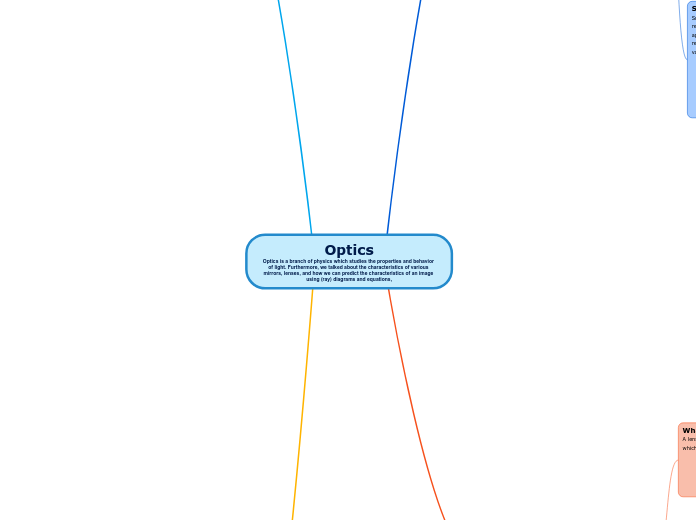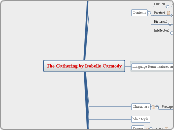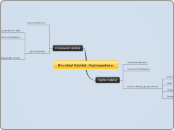Optics
Optics is a branch of physics which studies the properties and behavior of light. Furthermore, we talked about the characteristics of various mirrors, lenses, and how we can predict the characteristics of an image using (ray) diagrams and equations,
In physics, energy is the quantitative property that must be transferred to an object in order to perform work on, or to heat, the object. Energy is a conserved quantity; the law of conservation of energy states that energy can be converted in form, but not created or destroyed
Looking into the Mirror & Images Formed
Mirror and Magnification Equation
These are equations that can be used to
find and verify the characteristics of an image produced by curved mirrors and/or
the location of the object
Mirror Equation
-The equation is : 1/f = 1/do + 1/di
-Tells us the distance between an (unknown) image
Magnification Equation
-Tells us the height of the (unknown) image
-The equation is as follows 1/do + -1/di= 1/ho+1/hi
What is a Mirror?
A mirror describes a smooth reflective surface
Curved mirror
Curved mirrors are a type of mirror which are cut from a sphere
Concave Mirror
-A type of mirror which falls inward/curves away from a viewer and allows light rays to converge (bend inwards and eventually intersect)
-The characteristics of an image produced by concave mirrors depend on the location of the object
Possible images that can be formed using concave mirrors(using Ray Diagrams)
Convex Mirror
-A type of mirror who’s reflective surface bulges outwards and allows light rays to diverge (go off in opposite ways)
-Produce images with the same characteristics (wherever the object is located)
Plane Mirror
-A plane mirror is essentially a smooth, flat, reflective surface
Discovering the Properties of Light
Types Of Objects
The type of object is critical in determining how light will behave when it hits the given medium
Nuclear energy originates from the splitting of uranium atoms – a process called fission.
This generates heat to produce steam, which is used by a turbine generator to generate electricity. Because nuclear power plants do not burn fuel, they do not produce greenhouse gas emissions.
Write down the advantages and disadvantages of Nuclear Energy.
Transparent
-Describes an object which allows all light to pass through
-Examples include clean glass, water, oxygen etc.
Source:https://cdn.shopify.com/s/files/1/0338/5478/3626/products/transparent_-transclucent_-opaque_670x.progressive.jpg?v=1603154546
Transluscent
-Describes an object which allows some light to pass through
-Examples include frosted glass, wax paper, and fog
Source:https://cdn.shopify.com/s/files/1/0338/5478/3626/products/transparent_-transclucent_-opaque_670x.progressive.jpg?v=1603154546
Opaque
-Describes objects which do not allow any light to pass through (to be transmitted)
-Examples include wooden blocks, foam cups, rubber balls, Aluminium foil etc.
Source:https://cdn.shopify.com/s/files/1/0338/5478/3626/products/transparent_-transclucent_-opaque_670x.progressive.jpg?v=1603154546
What are Properties of Light?
Properties of light are things we can use to descibe specific light incidents; we can talk about color, how it behaves, and evn it's energy.
A wind turbine, or alternatively referred to as a wind energy converter, is a device that converts the wind's kinetic energy into electrical energy.
Wind turbines are manufactured in a wide range of vertical and horizontal axis.
Write down the advantages and disadvantages of Wind turbines.
Behavior of Light
When light is emitted from a source and it collides with an object there are 3 things that could happen; the light can be absorbed, transmitted and/or reflected
Reflection
-The light essentially bounces of the surface of the medium/object
-There are two types of reflection which depend on the object the light is reflecting off of
Types of reflection
Specular Reflection
-This type occurs when light strikes a smooth usually shiny reflective surface
- The light rays reflect at the same angle as the angle of the source hitting the surface
-The image produced is clear
Diffuse Reflection
-The light bounce back at different angles and is scattereing to all different directions
-The image produced isn't clear
-The object is usually rough and dull
Law of Reflection
-When light bounces of plane (a flat reflective surface like a) mirror it states the angle of incidence is equal the angle of reflection
*Note:Curved mirrors are basically a bunch of small plane mirrors put together therefore there are many normals along the mirror and an angle of incidence will be equivalent to the angle of reflection
Sourfe:http://hyperphysics.phy-astr.gsu.edu/hbase/phyopt/Fermat.html
Transmission
-The light is essentially transmitted or passes through the object
Absorption
-No light passes through the object when light is absorbed
-The light energy is absorbed and converted into heat/thermal energy
How does light travel?
-Light travels in straight lines called light rays
-It travels through empty spaces
What is Visible Light?
Visible light is a form of energy that can be seen by our eyes; it’s a section of waves from the the electromagnetic spectrum we can see
-Light can come from the sun,
Solar energy begins with the sun. Solar panels are used to convert light from the sun, which is composed of particles of energy called 'photons', into electricity that can be used to power electrical loads.
Write down the benefits of using solar panels.
How do we see color?
-All other colors of lisht is absorbed except the colr of the object which is reflected
-The color of the object can be seen is determined by chemicals in the object (e.g plants are green because they contain cholorophyll)
What is White Light?
White light is light that is made up of all the colors on the visible light spectrum; it's a combination of red, orange, yellow, green, blue, indigo, and violet light.
What is the electromagnetic spetrum?
The electomagetic spectrum is a range of all forms of electromagnetic waves (organized from least amount of energy to most amount of energy)
Forming Images With Lenses
There are many different types of energy, which all fall into two primary forms – kinetic and potential.
Energy can transform from one type to another, but it can never be destroyed or created.
Thin Lens & Magnification Equation
These are equations that can be used to
find and verify the characteristics of an image produced by lenses and/or the location of the object
Chemical energy is stored in the bonds of atoms and molecules.
It is the energy that holds these particles together.
Stored chemical energy is found in food, natural gas, etc.
Give more examples.
Thin Lens Equation
-1/f = 1/do + 1/di
-Tells us the location and image type
Magnification Equation
-The equation is as follows 1/do + -1/di 1/ho+1/hi
-Tells us size of image, attitude, and magnification
What is a lens?
A lens is a tranparent/clear object with one or more curved sides which cause light to refract (bend)
Nuclear energy is stored in the nucleus of atoms.
This energy is released when the nuclei are combined (fusion) or split apart (fission).
Nuclear power plants split the nuclei of uranium atoms to produce electricity.
What element do they use to fuel nuclear power plants?
How does light travel through lenses?
-Light going through a lense refracts twice; once when the light enters from air to the lens then when the light leaves
-However in diagrams we usually simplify the diagram and only show one point of refraction (bend)
Diverging Lens (Concave Lens)
Lens which are thinner in the middle which result in (parallel) light rays spreading apart (diverging)
Converging Lens (Concave Lens)
Lens which are thicker in the middle and result in (parallel) light rays meeting together (converging) at a point (the focal point)
Possible Images created by converging lens
Bending Light Using Refraction
Energy storage is the capture of energy produced at one time for use at a later time. A device that stores energy is generally called an accumulator or battery.
Snell's Law
Snell’s Law describes a relationship between angle of incidence, refraction, and index of refraction between 2 media; this law can be applied as an equation that can be used to find the unknown index of reflection, angle of incidence and angle of refraction using known values
Flywheel energy storage (FES) works by accelerating a rotor to a very high speed and maintaining the energy in the system as rotational energy.
Write down the main components of a typical flywheel.
Index of Refraction
-The ratio of the speed of light in a vacuum compared to the speed of light in another medium
-The index of refraction of a medium may also be called optical density.
Thermal energy storage is achieved with widely differing technologies.
Depending on the specific technology, it allows excess thermal energy to be stored and used hours, days, months later, at scales ranging from the individual process, to building or town.
What are 3 types of thermal energy?
What is Refraction?
-Descibes light rays bending/changing in direction as it travels from one medium to another medium
-It is abbreviated with capital R
The battery acquires its charged condition either by recharging or in the manufacturing of the unit.
During discharge, the chemical on the anode releases electrons, and ions in the electrolyte undergo an oxidation reaction.
Name the particular compounds in which energy is stored:
Critical Angle
The critical angle is the angle of incidence when the angle of refraction is at 90 (note critical angles can only be identified if the first medium is optically more dense than the second); for total internal reflection to occur the angle of incidence must be beyond the critical angle
Total Internal Reflection
Describes a phenomenon where all light is reflected off the boundary (between 2 media) back into the medium of incidence and no refraction occurs
Partial Refreaction
Partial Refraction describes a unique phenomenon where some light is refracted and rest is reflected
Cause Of Refraction
Refraction is caused by light travelling between two mediums which have a difference in optical density; objects with lower optical density travel faster than objects with higher optical density.









